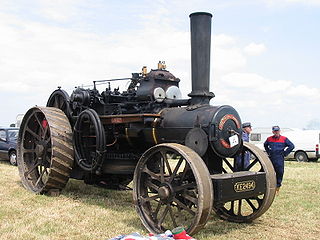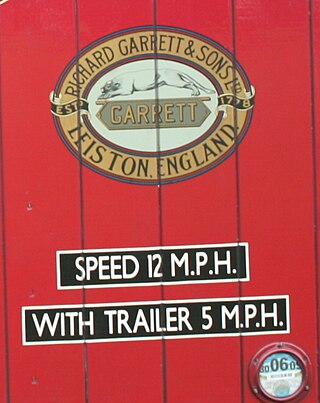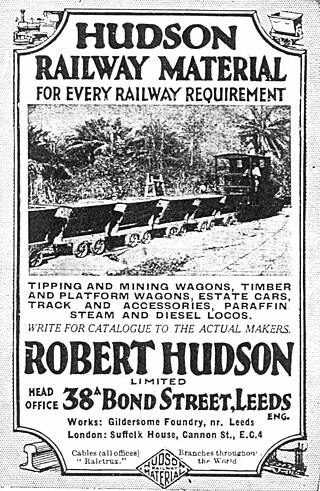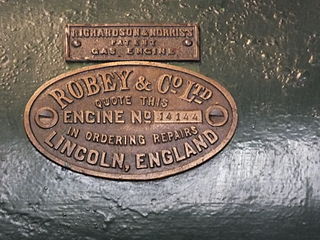

Mann's Patent Steam Cart and Wagon Company manufactured steam powered road vehicles in Leeds, England. [1]


Mann's Patent Steam Cart and Wagon Company manufactured steam powered road vehicles in Leeds, England. [1]
The company was founded by James Hutchinson Mann, a native of Leeds. Mann had been apprenticed to J&H McLaren & Co. and also worked for Marshall, Sons & Co. of Gainsborough. In January 1894 he commenced a partnership with Sidney Charlesworth under the title Mann and Charlesworth, and their works was in Canning Street, off Dewsbury Road, Leeds. This company manufactured traction engines, portable engines and steam rollers. [2] They also did conversions on engines from simple to compound operation, and made boilers. [3]
One of their notable inventions was the single-eccentric reversing gear. This compact device allowed the sequence of valve opening of a steam engine to be changed, both in terms of "cut-off" and "direction" without the need for link motion and all the associated levers. Around 1898 Mann and Charlesworth produced, on behalf of Philip Parmiter of Tisbury, an agricultural steam cart using the front end of a conventional traction engine and a roller at the rear. [4] This was one of the first practical self-powered load-carrying road vehicles. Mann realised the potential for this machine and went on to develop it into his "Patent Steam Cart" – to which the company title referred.

Charlesworth left the partnership in 1898 and by September 1899 the organisation called Mann's Patent Steam Cart and Wagon Company was registered. The success of the patent cart was such that Mann decided to construct a new works on Pepper Road, Hunslet, Leeds and the move was complete by December 1901. The large, modern, well-equipped works was an ambitious move and was initially very successful. The period up to and including the First World War was the heyday of the company.
The company's main products were their 3-ton and 5-ton wagons, and these were produced in a whole range of variations, including Articulated 6-wheeler, Gully cleaning wagon, Brewers wagon, Bus bodied wagon, Municipal dustcart, Street watering wagon, Tar spraying wagon, Tipping wagon and many more. In addition the company produced a range of tractors for both road and agricultural use. Another popular product for municipal use was their lightweight patching roller, used for road repair. In 1924 the company introduced their superb Mann Express wagon, with shaft drive, high-speed engine and fully enclosed cab. Unfortunately this wagon was not a commercial success and by 1926 Mann's Patent Steam Cart and Wagon Company was in trouble. Despite attempts to provide additional finance it was not possible to save the company, and in 1929 the works closed completely.
In February 1929 Mann's Patent Steam Car and Wagon Co Ltd was purchased by Atkinson Walker Wagons Limited, of Preston, who were also manufacturers of steam wagons, and in March 1929 the Pepper Road Works and the production equipment was auctioned off. [5] Atkinson renamed the company Mann’s Steam & Motor Wagon Company. However Atkinson were in a poor financial position, and as a result they sold the Mann business in 1930 to Scammell and Nephew of Spitalfields, London E1. Scammell produced a few Mann wagons, largely from the spares they acquired.

A traction engine is a steam-powered tractor used to move heavy loads on roads, plough ground or to provide power at a chosen location. The name derives from the Latin tractus, meaning 'drawn', since the prime function of any traction engine is to draw a load behind it. They are sometimes called road locomotives to distinguish them from railway locomotives – that is, steam engines that run on rails.

A steamroller is a form of road roller – a type of heavy construction machinery used for leveling surfaces, such as roads or airfields – that is powered by a steam engine. The leveling/flattening action is achieved through a combination of the size and weight of the vehicle and the rolls: the smooth wheels and the large cylinder or drum fitted in place of treaded road wheels.

Hunslet is an inner-city area in south Leeds, West Yorkshire, England. It is 1 mile (1.6 km) southeast of the city centre and has an industrial past.

Aveling and Porter was a British agricultural engine and steamroller manufacturer. Thomas Aveling and Richard Thomas Porter entered into partnership in 1862, and developed a steam engine three years later in 1865. By the early 1900s, the company had become the largest manufacturer of steamrollers in the world. The company used a rampant horse as its logo derived from the White Horse of Kent.

Thornycroft was an English vehicle manufacturer which built coaches, buses, and trucks from 1896 until 1977.
Scammell Lorries Limited was a British manufacturer of trucks, particularly specialist and military off-highway vehicles, between 1921 and 1988.

The Middleton Railway is the world's oldest continuously working railway, situated in the English city of Leeds. It was founded in 1758 and is now a heritage railway, run by volunteers from The Middleton Railway Trust Ltd. since 1960.

Karrier was a British marque of motorised municipal appliances and light commercial vehicles and trolley buses manufactured at Karrier Works, Huddersfield, West Yorkshire, by Clayton and Co., Huddersfield, Limited. They began making Karrier motor vehicles in 1908 in Queen Street South, Huddersfield. In 1920, H.F. Clayton sold Clayton and Co's Huddersfield business into public listed company Karrier Motors while keeping their Penistone operation separate. Mechanical and electrical engineers Clayton & Co Penistone, remain active in 2020 as Clayton Penistone Group.

John Fowler & Co Engineers of Leathley Road, Hunslet, Leeds, West Yorkshire, England produced traction engines and ploughing implements and equipment, as well as railway equipment. Fowler also produced the Track Marshall tractor which was a tracked version of the Field Marshall. British Railways Engineering Department locomotives ED1 to ED7 were built by Fowler

Richard Garrett & Sons was a manufacturer of agricultural machinery, steam engines and trolleybuses. Their factory was Leiston Works, in Leiston, Suffolk, England. The company was founded by Richard Garrett in 1778.

J&H McLaren was a British engineering company in Hunslet, Leeds, England, that manufactured traction engines, stationary engines and later, diesel engines.

Greenwood & Batley were a large engineering manufacturer with a wide range of products, including armaments, electrical engineering, and printing and milling machinery. They also produced a range of battery-electric railway locomotives under the brand name Greenbat. The works was in Armley, Leeds, UK.

Thomas Green & Son, Ltd. were engineers who manufactured a wide range of products at the Smithfield Foundry, Leeds, United Kingdom

Robert Hudson Ltd was a major international supplier of light railway materials, based in Gildersome, near Leeds, England. The name was later changed to Robert Hudson (Raletrux) Ltd.

Charles Burrell & Sons were builders of steam traction engines, agricultural machinery, steam lorries and steam tram engines. The company were based in Thetford, Norfolk and operated from the St Nicholas works on Minstergate and St Nicholas Street, some of which survives today.

A steam wagon is a steam-powered truck for carrying freight. It was the earliest form of lorry (truck) and came in two basic forms: overtype and undertype, the distinction being the position of the engine relative to the boiler. Manufacturers tended to concentrate on one form or the other.

The Yorkshire Patent Steam Wagon Co. was a steam wagon manufacturer in Leeds, England. They produced their first wagon in 1901. Their designs had a novel double-ended transverse boiler. In 1911 the company's name was changed to Yorkshire Commercial Motor Co., but reverted to Yorkshire Patent Steam Wagon Co. in 1922. Steam wagon production ceased in 1937, and the company was finally dissolved in 1993.

James & Fred Howard of Britannia Ironworks, Bedford, later known simply as Howards, were one of the largest English makers of agricultural equipment, steam traction engines, and light railway equipment. At The Great Exhibition of 1851 they exhibited a range of horse-drawn implements. After World War I, Howards became part of AGE, Agricultural & General Engineers, along with many of the other British makers of similar machinery.

Robey and Co. was an engineering company based in Lincoln, Lincolnshire, England which can be traced back to around 1849.